Thermoelectric Energy Micro Harvesters with Temperature Sensors Manufactured Utilizing the CMOS-MEMS Technique
Abstract
:1. Introduction
2. Design and Analysis of the Thermoelectric Energy Micro Harvester
3. Fabrication of the Thermoelectric Energy Micro Harvester
4. Results
5. Conclusions
Author Contributions
Funding
Acknowledgments
Conflicts of Interest
References
- Jaziri, N.; Boughamoura, A.; Müller, J.; Mezghani, B.; Tounsi, F.; Ismail, M. A comprehensive review of Thermoelectric Generators: Technologies and common applications. Energy Rep. 2020, 6, 264–287. [Google Scholar] [CrossRef]
- Guan, M.; Wang, K.; Xu, D.; Liao, W. Design and experimental investigation of a low-voltage thermoelectric energy harvesting system for wireless sensor nodes. Energy Convers. Manag. 2017, 138, 30–37. [Google Scholar] [CrossRef]
- Wahbah, M.; Alhawari, M.; Mohammad, B.; Saleh, H.; Ismail, M. Characterization of human body-based thermal and vibration energy harvesting for wearable devices. IEEE J. Emerg. Sel. Top. Circuits Syst. 2014, 4, 354–363. [Google Scholar] [CrossRef]
- Stoppa, M.; Chiolerio, A. Wearable electronics and smart textiles: A critical review. Sensors 2014, 14, 11957–11992. [Google Scholar] [CrossRef] [PubMed] [Green Version]
- Thielen, M.; Sigrist, L.; Magno, M.; Hierold, C.; Benini, L. Human body heat for powering wearable devices: From thermal energy to application. Energy Convers. Manag. 2017, 131, 44–54. [Google Scholar] [CrossRef] [Green Version]
- Leonov, V. Thermoelectric energy harvesting of human body heat for wearable sensors. IEEE Sens. J. 2013, 13, 2284–2291. [Google Scholar] [CrossRef]
- Torfs, T.; Leonov, V.; Vullers, R. Pulse oximeter fully powered by human body heat. Sens. Transd. J. 2007, 80, 1230–1238. [Google Scholar]
- Bavel, M.V.; Leonov, V.; Yazicioglu, R.; Torfs, T.; Hoof, C.V.; Posthuma, N.E.; Vullers, R. Wearable battery-free wireless 2-channel EEG systems powered by energy scavengers. Sens. Transd. J. 2008, 94, 103–115. [Google Scholar]
- Wu, Z.; Wang, J.; Bian, C.; Tong, J.; Xia, S. A MEMS-based multi-parameter integrated chip and its portable system for water quality detection. Micromachines 2020, 11, 63. [Google Scholar] [CrossRef] [Green Version]
- Dai, C.L.; Chen, Y.L. Modeling and manufacturing of micromechanical RF switch with inductors. Sensors 2007, 7, 2660–2670. [Google Scholar] [CrossRef] [Green Version]
- Wan, Y.; Li, Z.; Huang, Z.; Hu, B.; Lv, W.; Zhang, C.; San, H.; Zhang, S. Wafer-level self-packaging design and fabrication of MEMS capacitive pressure sensors. Micromachines 2022, 13, 738. [Google Scholar] [CrossRef]
- Kao, P.H.; Dai, C.L.; Hsu, C.C.; Lee, C.Y. Fabrication and characterization of a tunable In-plane resonator with low driving voltage. Sensors 2009, 9, 2062–2075. [Google Scholar] [CrossRef]
- Liu, J.; Hong, Y.; Wang, J.; Cai, C.; Zhang, Z. A thermoelectric MEMS microwave power sensor with inline self-detection function. Micromachines 2022, 13, 239. [Google Scholar] [CrossRef] [PubMed]
- Cheng, Y.C.; Dai, C.L.; Lee, C.Y.; Chen, P.H.; Chang, P.Z. A circular micromirror array fabricated by a maskless post-CMOS process. Microsyst. Technol. 2005, 11, 444–451. [Google Scholar] [CrossRef]
- Dai, C.L.; Chen, Y.C.; Wu, C.C.; Kuo, C.F. Cobalt oxide nanosheet and CNT micro carbon monoxide sensor integrated with readout circuit on chip. Sensors 2010, 10, 1753–1764. [Google Scholar] [CrossRef] [Green Version]
- Wang, Y.; Ma, Z.; Fu, G.; Wang, J.; Xi, Q.; Wang, Y.; Jia, Z.; Zi, G. A low-frequency MEMS magnetoelectric antenna based on mechanical resonance. Micromachines 2022, 13, 864. [Google Scholar] [CrossRef] [PubMed]
- Dai, C.L.; Peng, H.J.; Liu, M.C.; Wu, C.C.; Hsu, H.M.; Yang, L.J. A micromachined microwave switch fabricated by the complementary metal oxide semiconductor post-process of etching silicon dioxide. Jpn. J. Appl. Phys. 2005, 44, 6804–6809. [Google Scholar] [CrossRef]
- Su, J.; Vullers, R.J.M.; Goedbloed, M.; van Andel, Y.; Leonov, V.; Wang, Z. Thermoelectric energy harvester fabricated by Stepper. Microelectron. Eng. 2010, 87, 1242–1244. [Google Scholar] [CrossRef]
- Peng, S.W.; Shih, P.J.; Dai, C.L. Manufacturing and characterization of a thermoelectric energy harvester using the CMOS-MEMS technology. Micromachines 2015, 6, 1560–1568. [Google Scholar] [CrossRef] [Green Version]
- Zhang, S.; Liao, X.P. Research on micro-electro-mechanical system-based integrated energy harvester with test structures. Energy Technol. 2021, 9, 2100488. [Google Scholar] [CrossRef]
- Noyan, I.D.; Gadea, G.; Salleras, M.; Pacios, M.; Calaza, C.; Stranz, A.; Dolcet, M.; Morata, A.; Tarancon, A.; Fonseca, L. SiGe nanowire arrays based thermoelectric microgenerator. Nano Energy 2018, 57, 492–499. [Google Scholar] [CrossRef]
- Xie, J.; Lee, C.; Feng, H.H. Design, fabrication, and characterization of CMOS MEMS-based thermoelectric power generators. Microelectromech. Syst. 2010, 19, 317–324. [Google Scholar] [CrossRef]
- Yang, S.M.; Chen, M.D.; Tsai, M.H. The effect of in-plane thermocouple dimension on the performance of CMOS and BiCMOS thermoelectric generators. IEEE Sens. J. 2019, 19, 4829–4836. [Google Scholar] [CrossRef]
- Sun, M.; Liao, X.P. Modeling of the photoelectric-thermoelectric integrated micropower generator. IEEE Trans. Electron. Dev. 2021, 68, 4509–4515. [Google Scholar] [CrossRef]
- Glatz, W.; Muntwyler, S.; Hierold, C. Optimization and fabrication of thick flexible polymer based micro thermoelectric generator. Sens. Actuat. A 2006, 132, 337–345. [Google Scholar] [CrossRef]
- Huesgen, T.; Woias, P.; Kockmann, N. Design and fabrication of MEMS thermoelectric generators with high temperature efficiency. Sens. Actuat. A 2008, 145, 423–429. [Google Scholar] [CrossRef]
- Glatz, W.; Schwyter, E.; Durrer, L.; Hierold, C. Bi2Te3-Based Flexible Micro Thermoelectric Generator with Optimized Design. Microelectromech. Syst. 2009, 18, 763–772. [Google Scholar] [CrossRef]
- Wang, W.; Jia, F.L.; Huang, Q.H.; Zhang, J.Z. A new type of low power thermoelectric micro-generator fabricated by nanowire array thermoelectric material. Microelectron. Eng. 2005, 77, 223–229. [Google Scholar] [CrossRef]
- Kao, P.H.; Shih, P.J.; Dai, C.L.; Liu, M.C. Fabrication and characterization of CMOS-MEMS thermoelectric micro generators. Sensors 2010, 10, 1315–1325. [Google Scholar] [CrossRef] [Green Version]
- Dai, C.L.; Xiao, F.Y.; Juang, Y.Z.; Chiu, C.F. An approach to fabricating microstructures that incorporate circuits using a post-CMOS process. Micromech. MIcroeng. 2005, 15, 98–103. [Google Scholar] [CrossRef]
- Avraham, M.; Stolyarova, S.; Blank, T.; Bar-Lev, S.; Golan, G.; Nemirovsky, Y. A novel miniature and selective CMOS gas sensor for gas mixture analysis—Part 2: Emphasis on physical aspects. Micromachines 2020, 11, 587. [Google Scholar] [CrossRef] [PubMed]
- Dai, C.L.; Chiou, J.H.; Lu, M.S.C. A maskless post-CMOS bulk micromachining process and its application. J. Micromech. Microeng. 2005, 15, 2366–2371. [Google Scholar] [CrossRef]
- Shen, W.C.; Shih, P.J.; Tsai, Y.C.; Hsu, C.C.; Dai, C.L. Low-concentration ammonia gas sensors manufactured using the CMOS–MEMS technique. Micromachines 2020, 11, 92. [Google Scholar] [CrossRef] [Green Version]
- Dai, C.L.; Chen, H.L.; Chang, P.Z. Fabrication of a micromachined optical modulator using the CMOS process. Micromech. Microeng. 2001, 11, 612–615. [Google Scholar] [CrossRef]
- Cheng, Y.C.; Dai, C.L.; Lee, C.Y.; Chen, P.H.; Chang, P.Z. A MEMS micromirror fabricated using CMOS post-process. Sens. Actuat. A 2005, 120, 573–581. [Google Scholar] [CrossRef]
- Dai, C.L.; Hsu, H.M.; Tsai, M.C.; Hsieh, M.M.; Chang, M.W. Modeling and fabrication of a microelectromechanical microwave switch. Microelectron. J. 2007, 38, 519–524. [Google Scholar] [CrossRef]
- Chen, S.J.; Wu, Y.C. Active thermoelectric vacuum sensor based on frequency modulation. Micromachines 2020, 11, 15. [Google Scholar] [CrossRef] [PubMed] [Green Version]
- Dai, C.L.; Kao, P.H.; Tai, Y.W.; Wu, C.C. Micro FET pressure sensor manufactured using CMOS-MEMS technique. Microelectron. J. 2008, 39, 744–749. [Google Scholar] [CrossRef]
- Lee, W.L.; Shih, P.J.; Hsu, C.C.; Dai, C.L. Fabrication and characterization of flexible thermoelectric generators using micromachining and electroplating techniques. Micromachines 2019, 10, 660. [Google Scholar] [CrossRef] [Green Version]
- Toriyama, T.; Yajima, M.; Sugiyama, S. Thermoelectric micro power generator utilizing self-standing polysilicon-metal thermopile. In Proceedings of the IEEE Micro Electro Mechanical Systems 2001, Interlaken, Switzerland, 25 January 2001; pp. 562–565. [Google Scholar]
- Gardner, J.W.; Varadan, V.K.; Awadelkarim, O.O. Microsensors MEMS and Smart Devices; John Wiley & Sons Ltd.: Chichester, UK, 2001. [Google Scholar]
- Chen, Y.W.; Wu, C.C.; Hsu, C.C.; Dai, C.L. Fabrication and testing of thermoelectric CMOS-MEMS microgenerators with CNCs film. Appl. Sci. 2018, 8, 1047. [Google Scholar] [CrossRef] [Green Version]
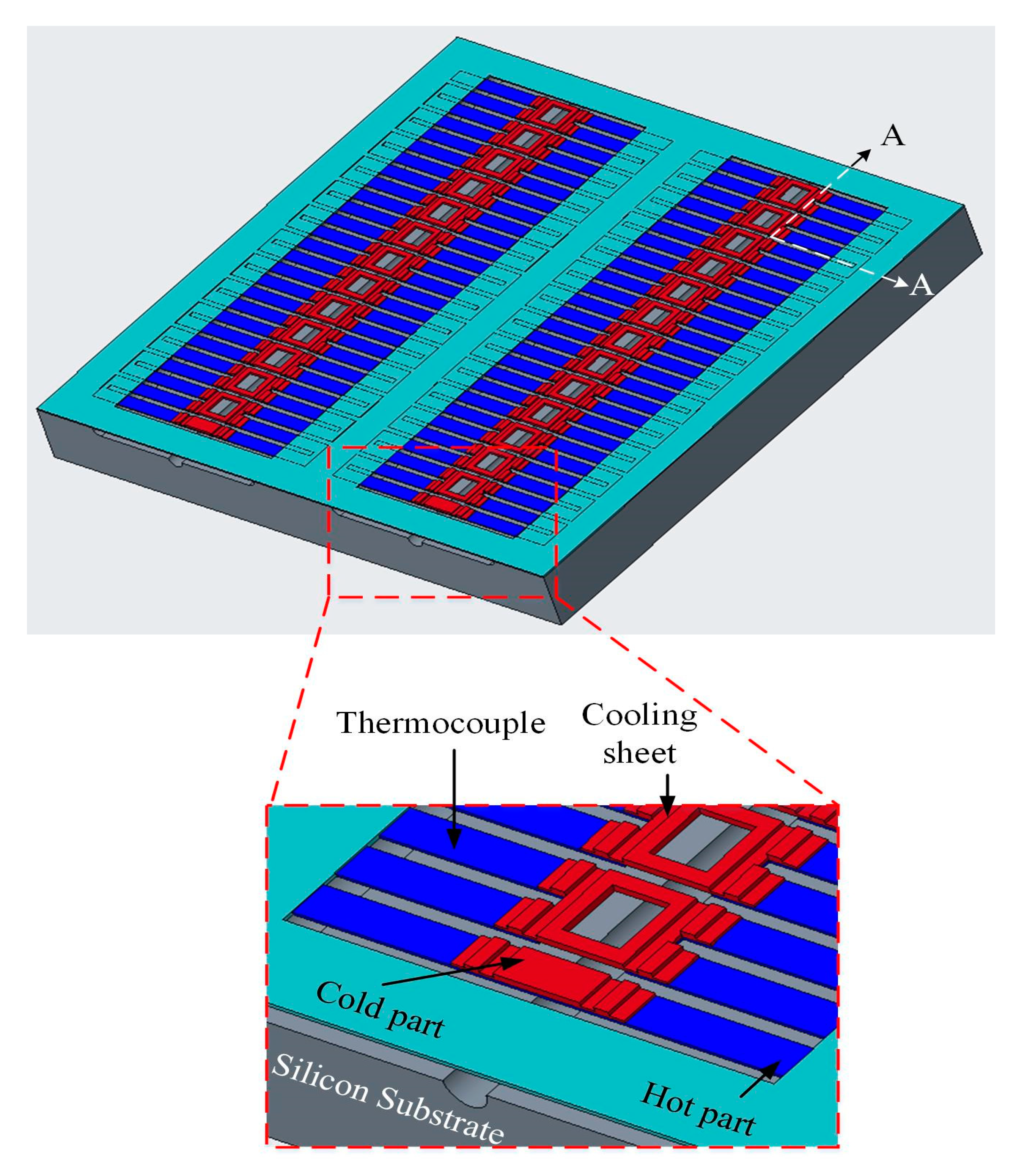
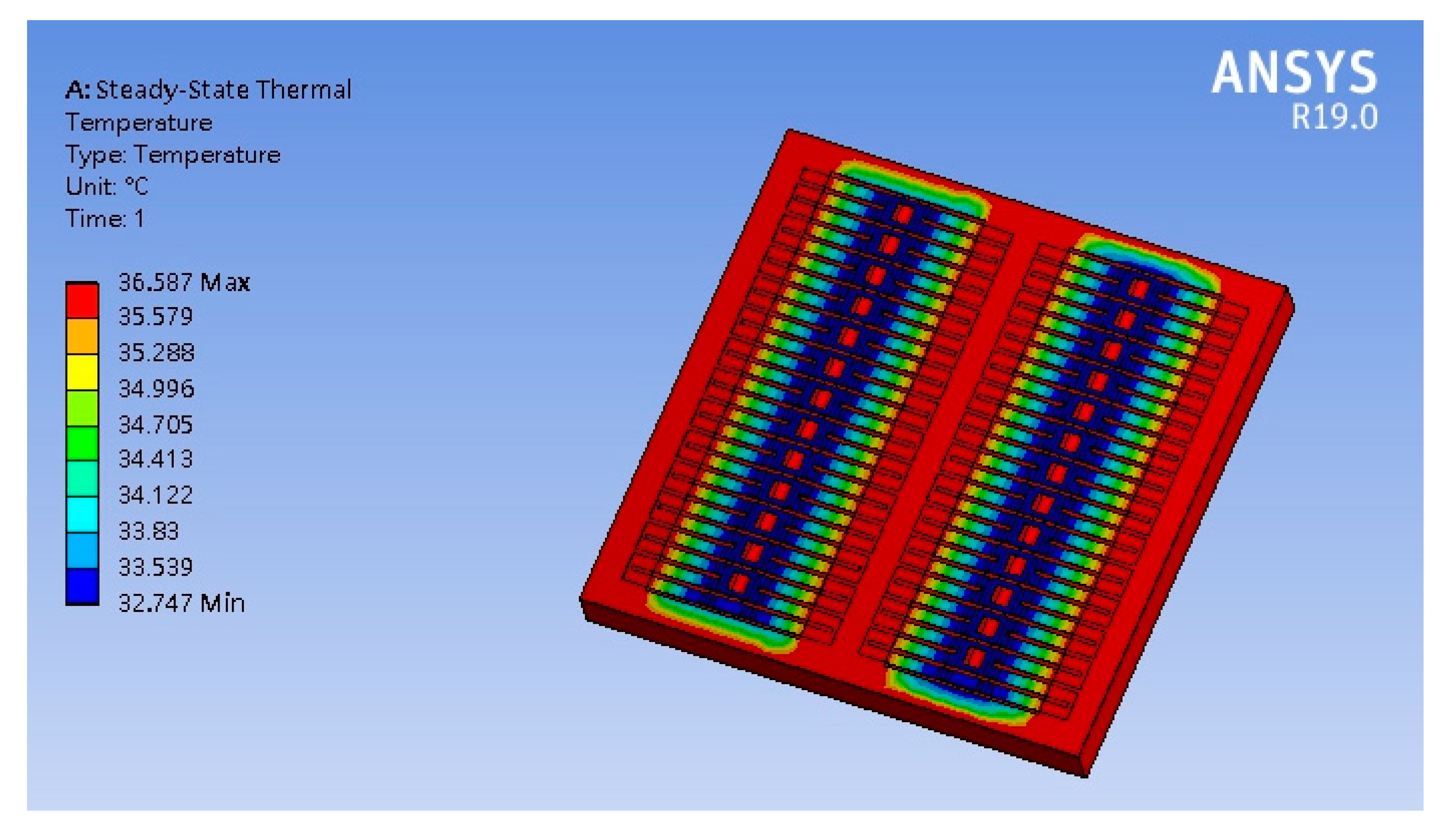
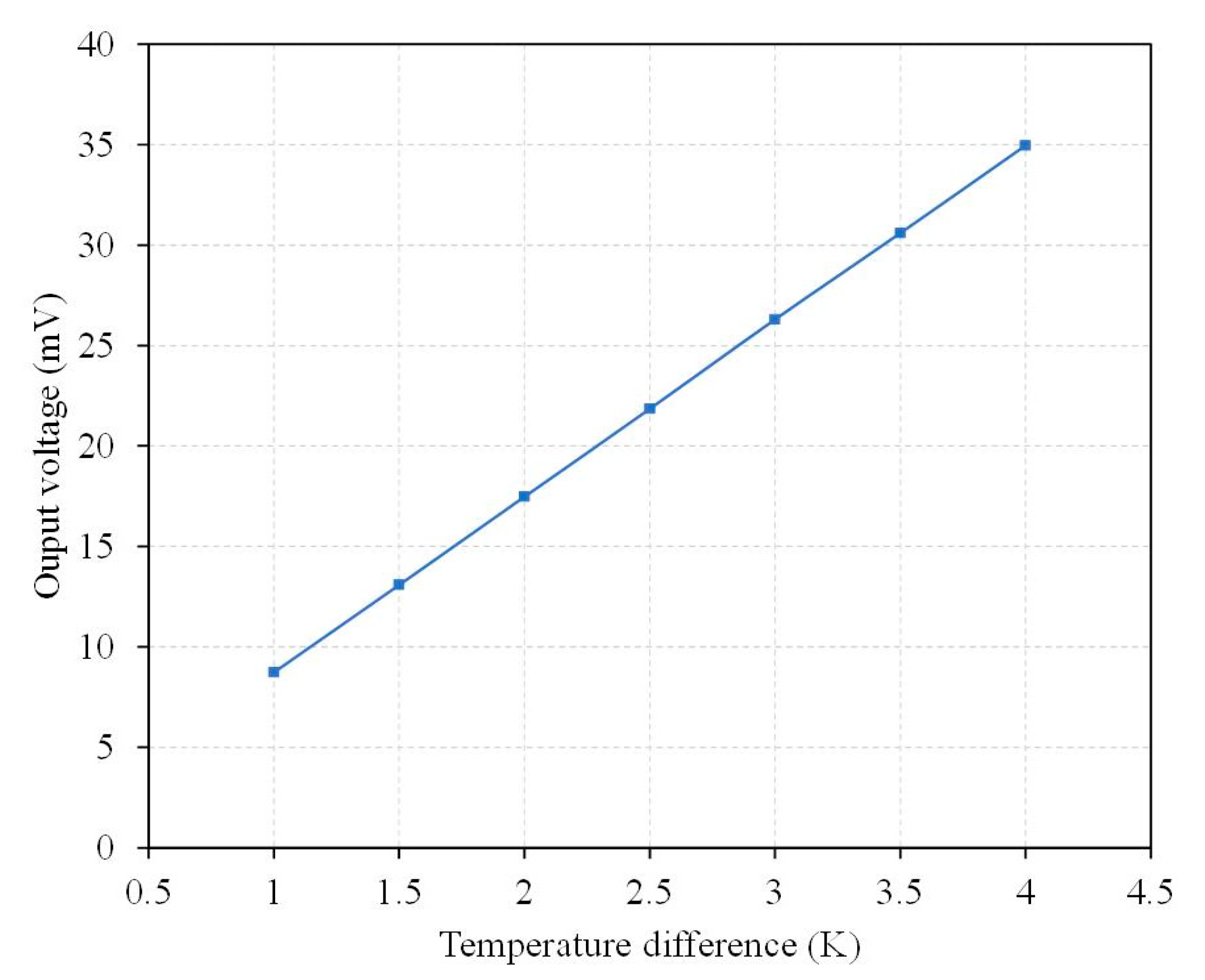

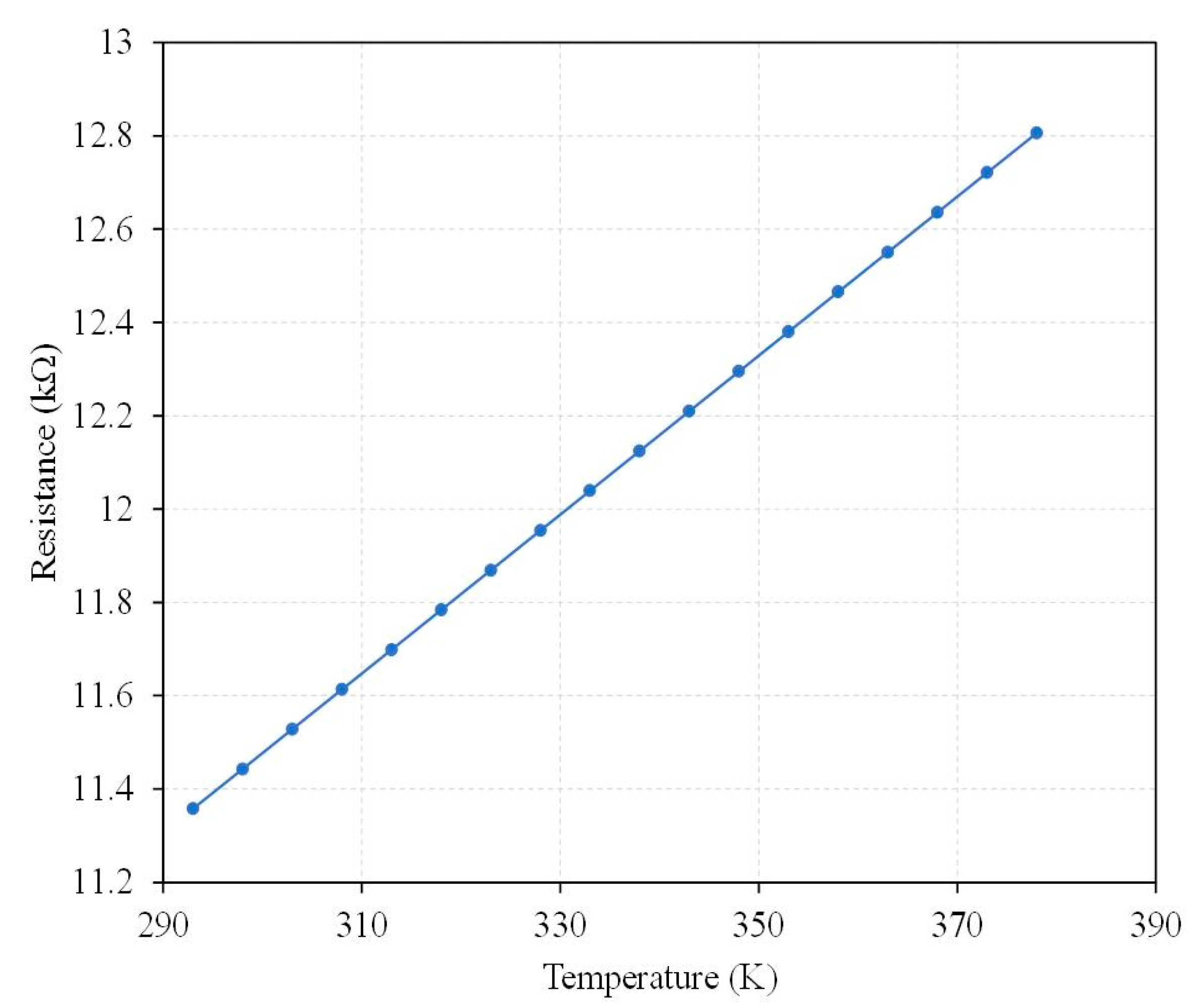
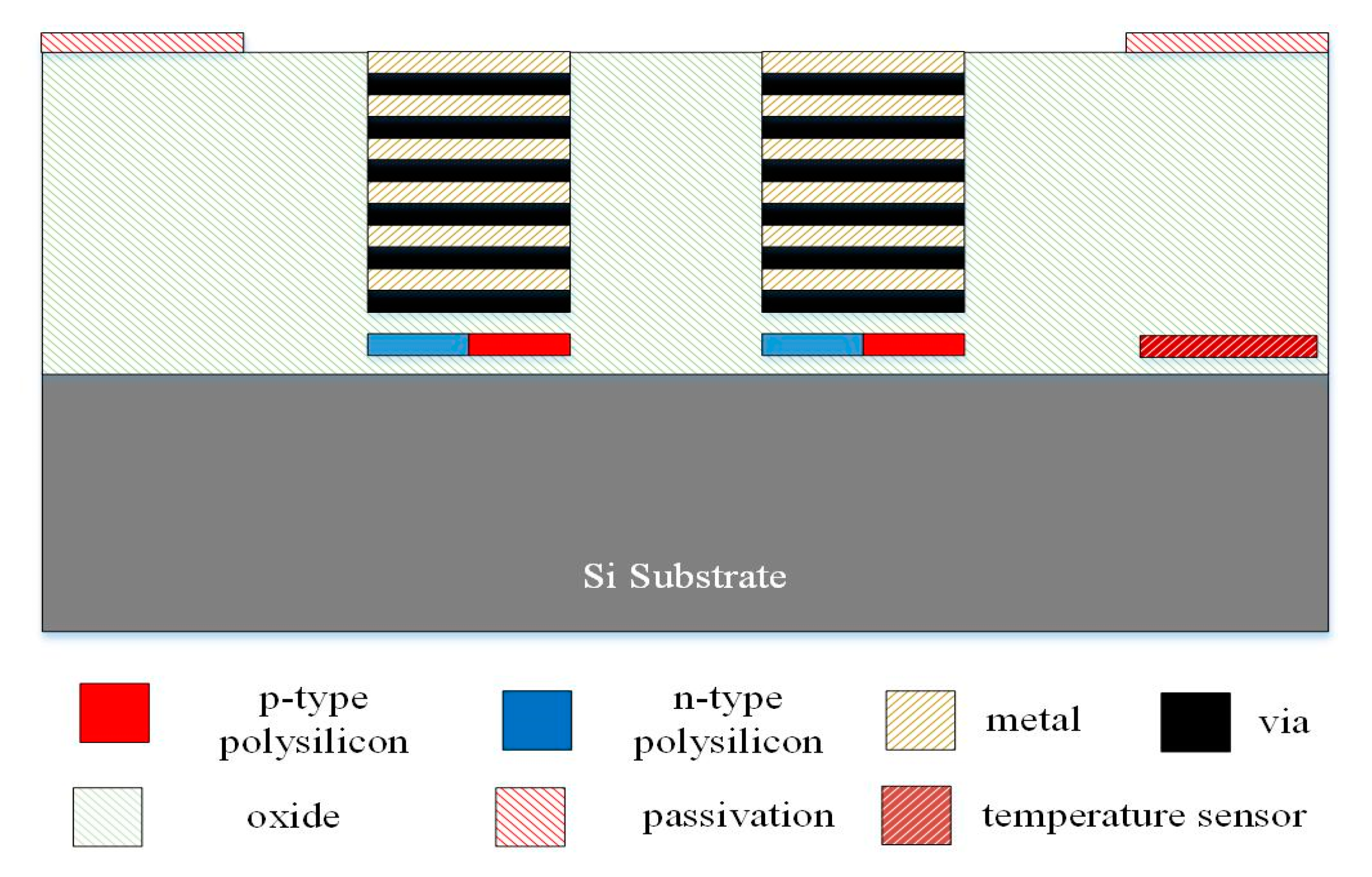

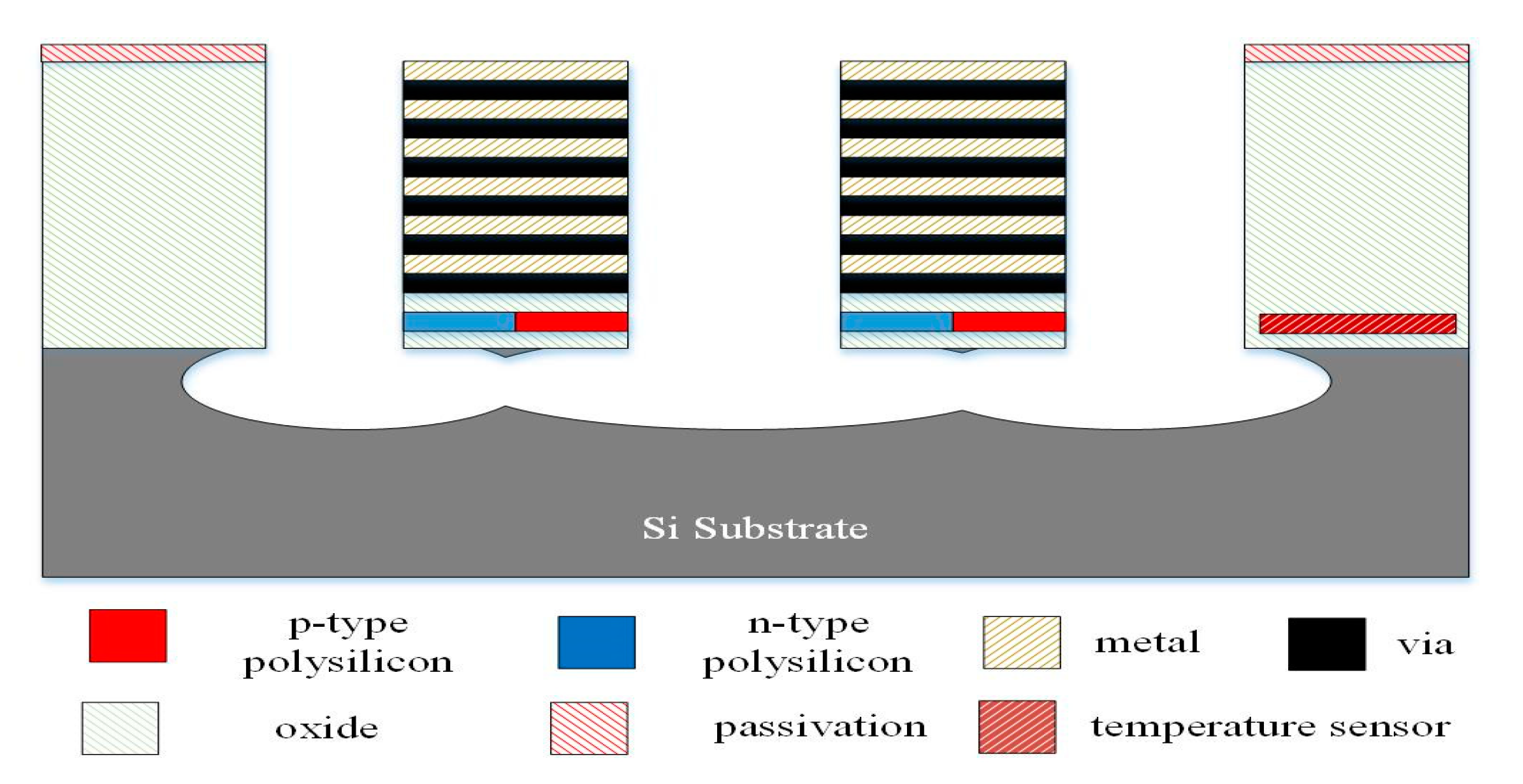


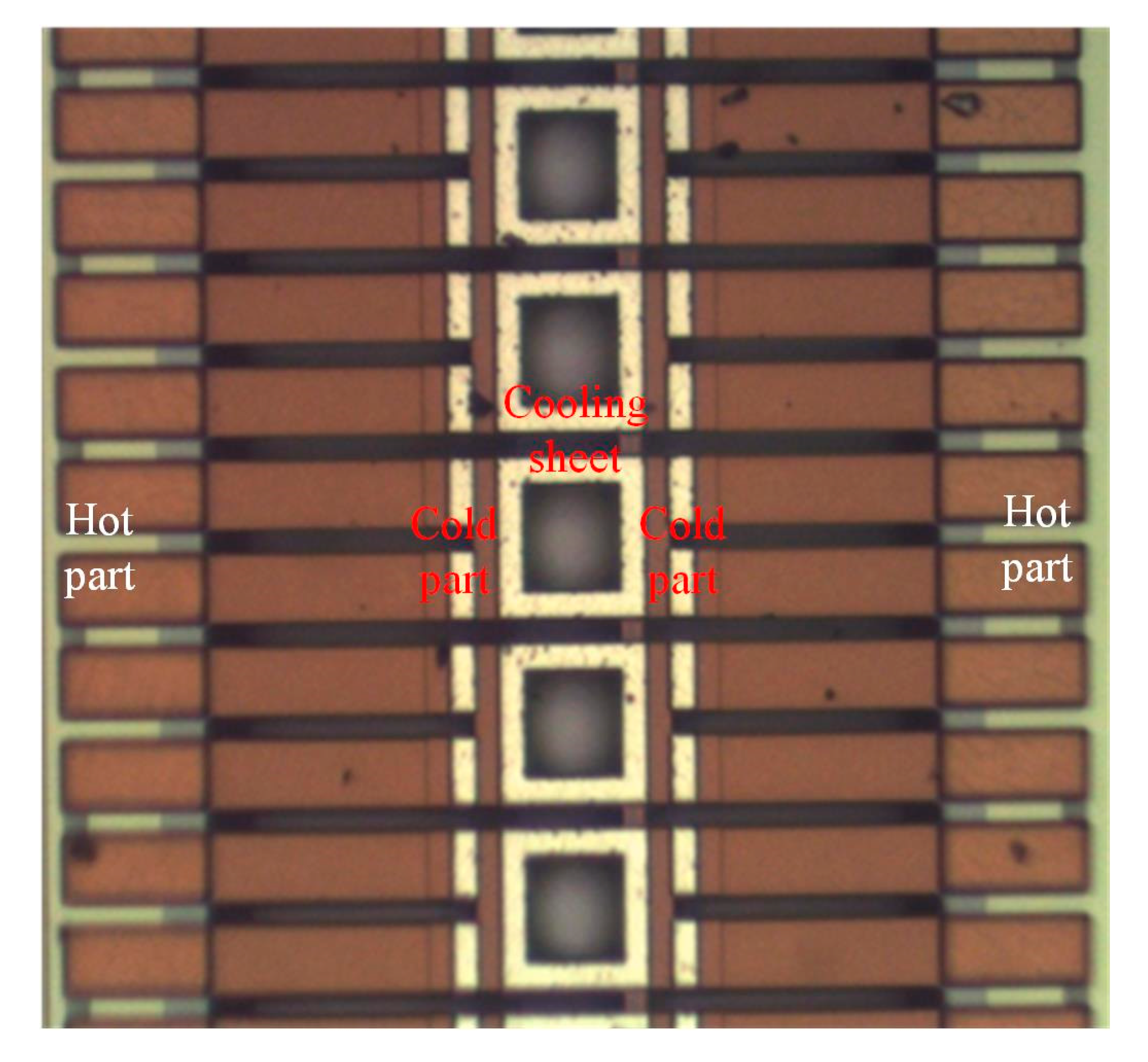
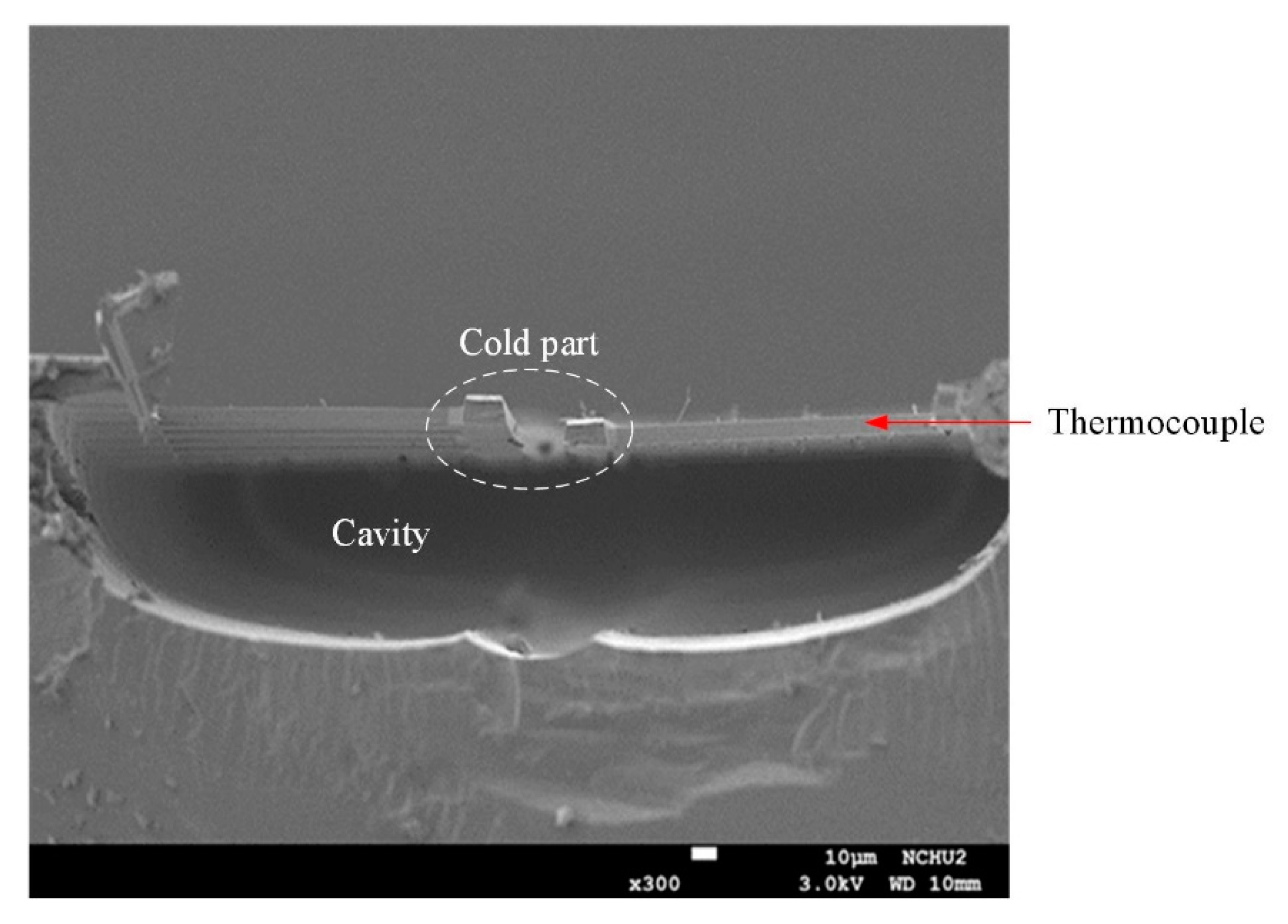
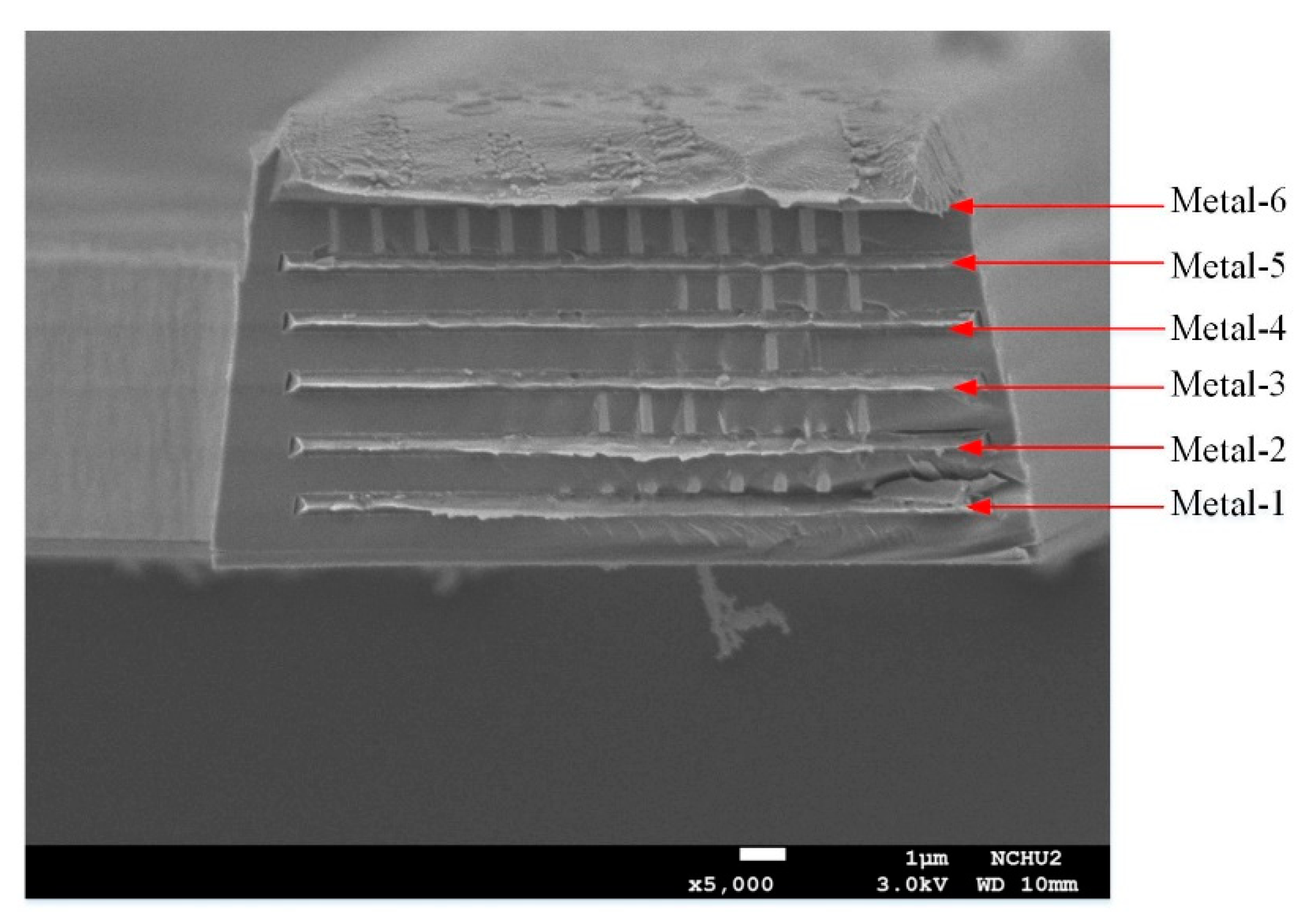

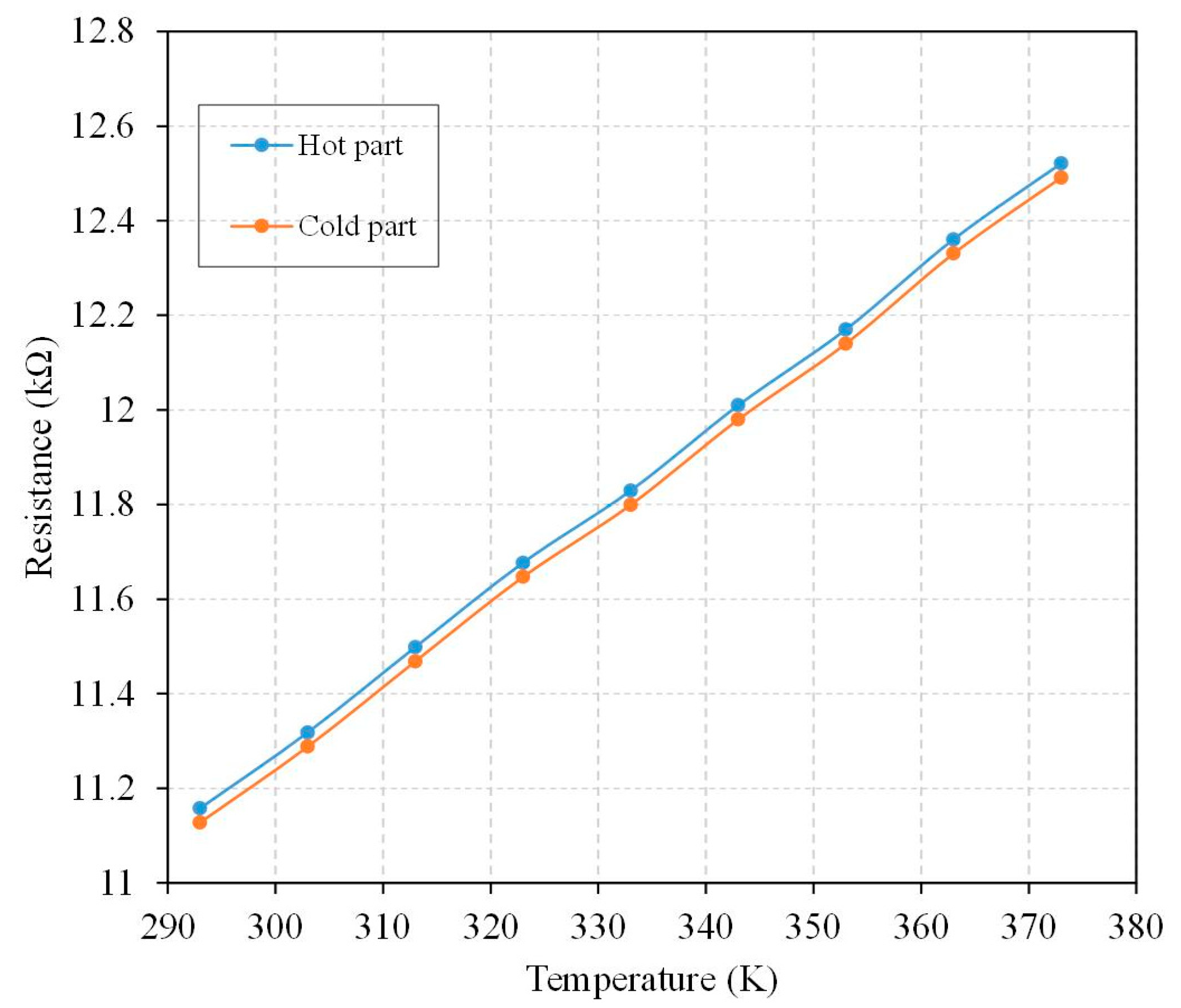
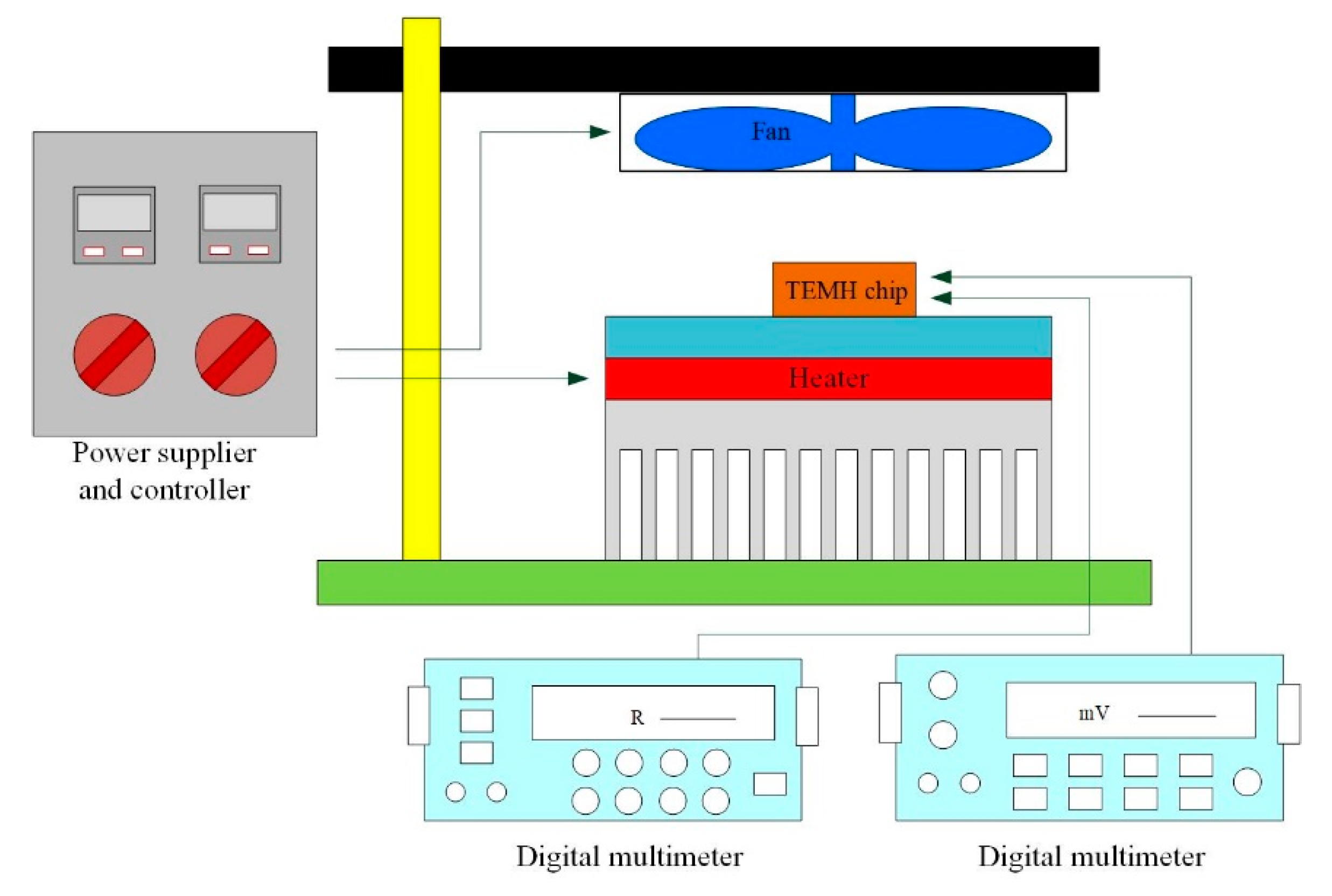

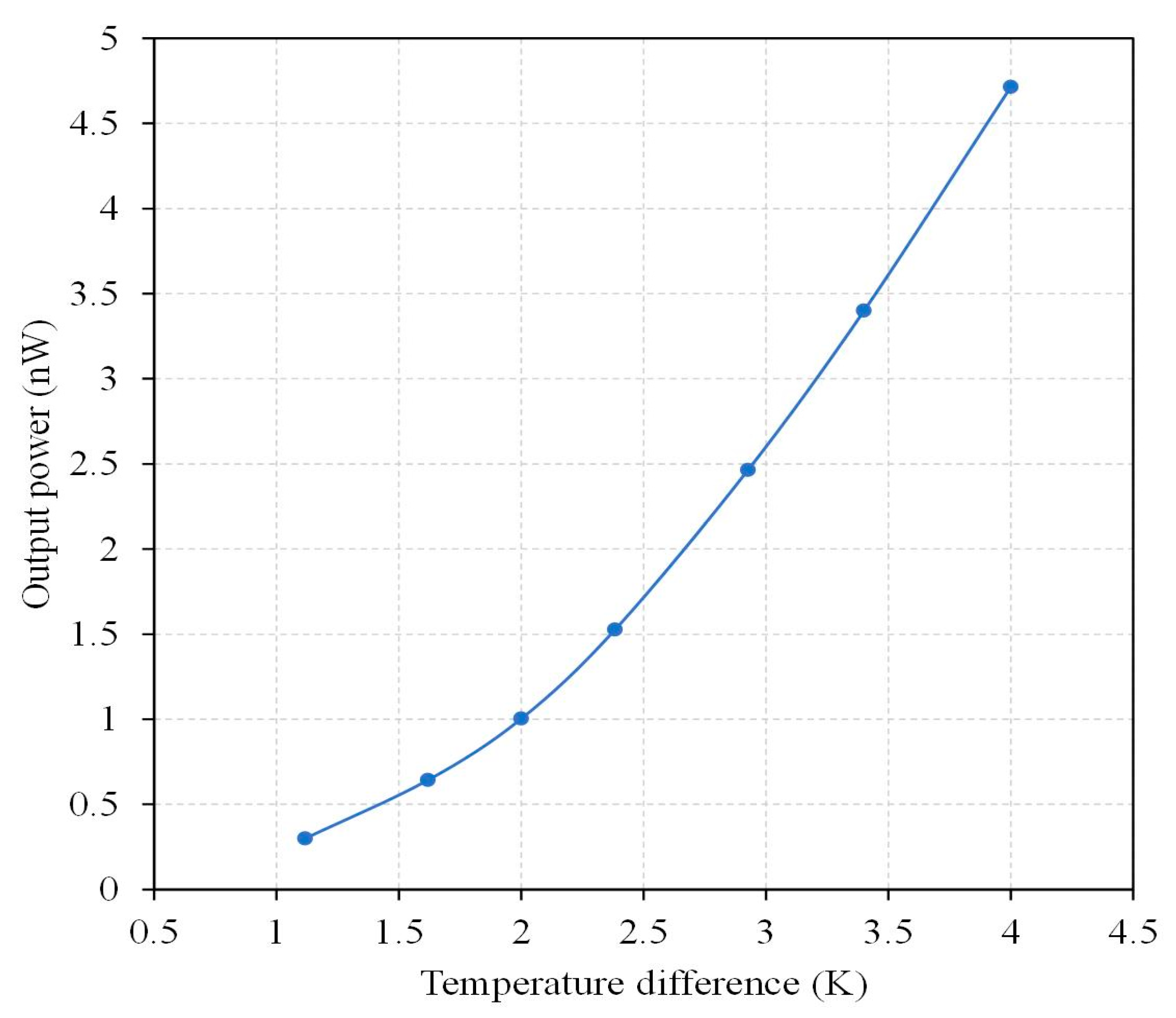
| Authors | Voltage Factor (mV/mm2K) | Power Factor (nW/mm2K2) |
|---|---|---|
| Peng [19] | 0.178 | 0.00147 |
| Zhang [20] | 5.8 | 0.276 |
| Xie [22] | ‒ | 0.52 |
| Yang [23] | 44.23 | 0.473 |
| Sun [24] | 3.16 | 0.0634 |
| Glatz [25] | ‒ | 8.3 |
| Huesgen [26] | ‒ | 3.63 |
| Glatz [27] | ‒ | 2.9 |
| Kao [29] | ‒ | 0.00064 |
| Material | Silicon | Aluminum | Polysilicon | Silicon Dioxide |
|---|---|---|---|---|
| Thermal conductivity (W/m·K) | 150 | 236 | 31.5 | 1.42 |
Publisher’s Note: MDPI stays neutral with regard to jurisdictional claims in published maps and institutional affiliations. |
© 2022 by the authors. Licensee MDPI, Basel, Switzerland. This article is an open access article distributed under the terms and conditions of the Creative Commons Attribution (CC BY) license (https://creativecommons.org/licenses/by/4.0/).
Share and Cite
Shen, Y.-X.; Tsai, Y.-C.; Lee, C.-Y.; Wu, C.-C.; Dai, C.-L. Thermoelectric Energy Micro Harvesters with Temperature Sensors Manufactured Utilizing the CMOS-MEMS Technique. Micromachines 2022, 13, 1258. https://doi.org/10.3390/mi13081258
Shen Y-X, Tsai Y-C, Lee C-Y, Wu C-C, Dai C-L. Thermoelectric Energy Micro Harvesters with Temperature Sensors Manufactured Utilizing the CMOS-MEMS Technique. Micromachines. 2022; 13(8):1258. https://doi.org/10.3390/mi13081258
Chicago/Turabian StyleShen, Yi-Xuan, Yao-Chuan Tsai, Chi-Yuan Lee, Chyan-Chyi Wu, and Ching-Liang Dai. 2022. "Thermoelectric Energy Micro Harvesters with Temperature Sensors Manufactured Utilizing the CMOS-MEMS Technique" Micromachines 13, no. 8: 1258. https://doi.org/10.3390/mi13081258
APA StyleShen, Y.-X., Tsai, Y.-C., Lee, C.-Y., Wu, C.-C., & Dai, C.-L. (2022). Thermoelectric Energy Micro Harvesters with Temperature Sensors Manufactured Utilizing the CMOS-MEMS Technique. Micromachines, 13(8), 1258. https://doi.org/10.3390/mi13081258







